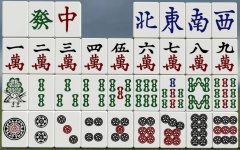Mahjong equipment: Difference between revisions
m (→Tenbou) |
|||
| Line 66: | Line 66: | ||
Point sticks are used to keep track of scores. In a sense, these sticks may be viewed as "money". Although, some gambling games may actually tie these point sticks to money. | Point sticks are used to keep track of scores. In a sense, these sticks may be viewed as "money". Although, some gambling games may actually tie these point sticks to money. | ||
In the event of [[Scoring|honba]], players use 100 point sticks and add them to the round indicator. These merely serve as markers, and when a dealer rotation occur, players keep their 100 point sticks used to keep track of the honba count. | In the event of [[Scoring|honba]], players use 100 point sticks and add them to the round indicator. These merely serve as markers, and when a dealer rotation occur, players keep their 100 point sticks used to keep track of the honba count, after a dealer rotation. | ||
{| class="wikitable" width="40%" align="right" | {| class="wikitable" width="40%" align="right" | ||
|- | |- | ||
Revision as of 23:48, 17 January 2014
Of course, the proper equipment is needed in order to play Japanese mahjong. Naturally, mahjong tiles are used. It is possible to play the game using printed cards; yet, it is actually cumbersome to do so. In practice, tiles have been the most effective way to play the game in person.
The game is also available online, video games, and software.
Japanese tiles
Japanese mahojng sets usually come with 144 tiles in a case. While 136 of the tile are used, the extra tiles are four red five dora tiles: one for manzu and souzu, and two for pinzu. To use these tiles, regular five tiles are switched with the red dora. The remaining four tile are four flower tiles, which are not used at all.
Typically, Japanese tiles are individually about the size 16 mm x 19 mm x 26 mm (WLH). Like most mahjong tile sets, these tiles are capable of standing on their own.

Man
| Ii wan | Ryan wan | San wan | Suu wan | Uu wan | Ro wan | Chii wan | Pa wan | Chuu man |
Manzu, or man/wan for short, composes the character tiles. The Chinese characters or Japanese kanji are used to indicate the numbers 1-9. While some sets have the alphanumeric representations of the numbers superscript on the upper right corners, it is actually best to remember the kanji for 1-9. Standard Japanese sets lack these alphanumeric superscripts.
Pin
| Ii pin | Ryan pin | San pin | Suu pin | Uu pin | Ro pin | Chii pin | Pa pin | Chuu pin |
Pinzu, or pin for short, composes the coin or circle tiles. The symbols represent the use of coins.
Sou
| Ii sou | Ryan sou | San sou | Suu sou | Uu sou | Ro sou | Chii sou | Pa sou | Chuu sou |
Souzu, or sou, composes the bamboo or stick tiles. Ordered 1-9, and it is special to note the 1-sou tile which is marked with a large bird instead of 1-stick to discourage cheating by tile alteration.
Kazehai
| Ton | Nan | Shaa | Pei |
Kazehai are the wind tiles. They are indicated as East, South, West, and North. The wind tiles correlate to the player seating, and so therefore, it is best to remember the wind tiles in the East, South, West, and North order, as they correspond to the seating order. Likewise, this is significant to note for yakuhai.
Sangenpai
| Haku | Hatsu | Chun |
Sangenpai are the dragon tiles. They are known as the dragons: white, green, and red. Just noting their color is sufficient enough here.
Mats
Mahjong mats are materials used to provide mahjong tiles a softer surface to slide all over. Naturally, the intent is to prevent or minimize the effect of friction onto the mahjong tiles. After prolonged play, the tiles may eventually wear themselves out and no longer be deemed usable.
Tenbou
Point sticks are used to keep track of scores. In a sense, these sticks may be viewed as "money". Although, some gambling games may actually tie these point sticks to money.
In the event of honba, players use 100 point sticks and add them to the round indicator. These merely serve as markers, and when a dealer rotation occur, players keep their 100 point sticks used to keep track of the honba count, after a dealer rotation.
| 100 point stick | |
| 1000 point stick | |
| 5000 point stick | |
| 10000 point stick |
At the start of the game, players begin with the regular 25,000 points:
- A single 10,000 stick
- Two 5,000 sticks
- Four 1,000 sticks
- Ten 100 sticks
Naturally, if players wish to change the starting value for the game, they may do so by adjusting this distribution.
Round indicator
Automatic tables
Automatic mahjong tables are used to expedite the process of tile shuffling and wall building.